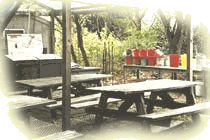
|
The outdoor education facility: |
 |
On an average school day in the fall or spring, between 11 and 18 high school students travel to the Center for Archaeology/BCPS to perform research employing the methods they have been reading about in their elective archaeology course. The students receive an hour long, on-site orientation and demonstration lecture and then they have an experience excavating for 1½ hours. The students also undertake a 1½-hour cultural landscape walking tour where remnants of Oregon town are viewed and various aspects of life in a furnace town are explored. The pig iron manufacturing process is explained at the furnace crucible ruins, everyday life experience is investigated at a reconstructed tenant house museum and period labor practices are addressed while viewing iron ore and marble quarries. Students also learn about and compare artifact assemblages recovered from tenant house sites and those from the yard of the Manager/Iron Master’s house. |
|
 |
The development of the archaeology education curriculum parallels the evolution of the Center's research program. This is how a portion of the integrated curriculum/ research project has operated to date:
|
 |
|
|
|
Recognition (Archaeology):
|
|
||
OUTDOOR |